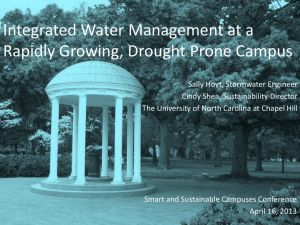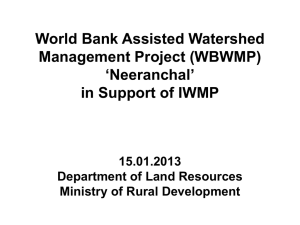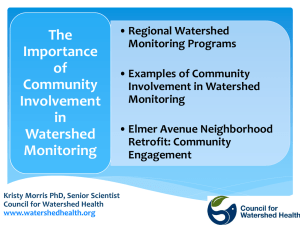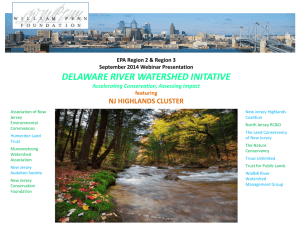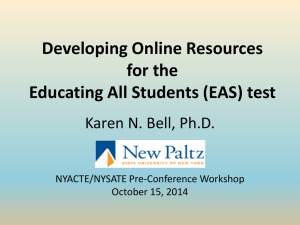Ordung.ppt
advertisement
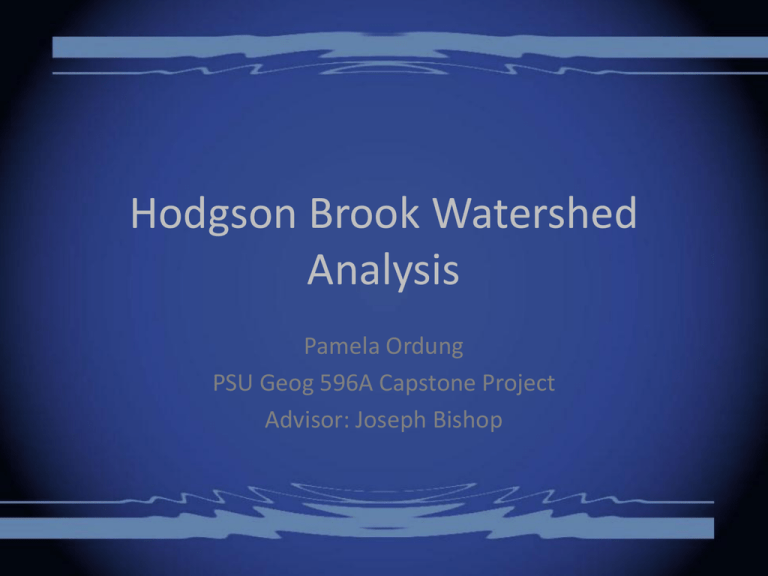
Hodgson Brook Watershed Analysis Pamela Ordung PSU Geog 596A Capstone Project Advisor: Joseph Bishop Me • GIS Technician • Love travel & hiking • Just bought my first house in Sterling, MA Presentation Outline • Background Information: Stormwater Runoff • Study Site – Regional & Local – Pollution – What has been done • Goals & Objectives • Methods & Materials – Materials – Proposed Steps • • • • • Project Implications Proposed Timeline References & Citations Acknowledgements Questions Stormwater Runoff • Pollution of streams, rivers, other water bodies • Role of Impervious surfaces • Stormwater management techniques *Image reproduced for educational purposes only (Chesapeake Bay Program 2012) Study Site: Hodgson Brook Watershed • Covers approximately 20% of the total land area in North Central Portsmouth, NH Study Site: Hodgson Brook Watershed • Nearly 55% of the watershed falls within the Pease International Tradeport • 32% of the watershed is covered with impervious surfaces • Empties into North Mill Pond Study Site: Impervious Examples • In the 1800’s mills were built along the brook urbanizing the area and straightening the course of the brook • In the 1950’s, the building of the Pease International Air Force Base (now Tradeport) and the highway system greatly changed the Hodgson Brook’s natural course. – Water diverted into Newfields Ditch & Grafton Ditch • Now the main conveyance of stormwater is through the stormwater collection system (outlined in red) – – – Built over the last 100 years Used to be abundant wetlands Wetlands that remain today are bordered and altered by roads, railways, and parking lots *Image reproduced for educational purposes only (D.B. Truslow Associates and the Hodgson Brook Local Advisory Committee 2004) Study Site: Pollution • Studies completed by the New Hampshire Department of Environmental Services (DES), the Hodgson Brook Local Advisory Committee (HBLAC), and the Advocates for the North Mill Pond (ANMP) have detected pollutants such as fecal coliform, nutrients, suspended sediments, metals, and organic chemicals in Hodgson Brook • Impervious surfaces play a key role in this contamination by directing runoff into the brook and surrounding wetlands • Other factors that contribute to this pollution in the watershed are due to sewage from cross connected storm drains, sewer pipes, and solid wastes such as trash and debris Study Site: What has been done? • Within the Pease International Tradeport – Rain gardens – Stormwater treatment wetlands – Pervious pavement • Other Suggestions from the Hodgson Brook Watershed Restoration Plan (2004) – Stormwater retrofitting – Daylighting *Image reproduced for educational purposes only (Clean Water Services 2013) Goals & Objectives : Goal #1 • Perform a watershed delineation in order to break the Hodgson Brook watershed into smaller subwatersheds and catchment areas – Create an efficient set of steps to perform this delineation – Aid in monitoring & planning done within the watershed by providing smaller, more defined study sites • Similar to a study done by Tighe & Bond (2011) for the town of West Springfield, MA • Example of the end results: – – Red outlines are the subwatersheds Yellow outlines are the Stormwater Basins, or catchment areas *Image reproduced for educational purposes only (Tighe & Bond, Inc. 2011) Goals & Objectives : Goal #2 • Create a tool to perform the delineation using ArcGIS ModelBuilder – – – – User will define impervious surface, model will calculate where the water will flow and from what portion of surface based on elevation data Creates a model that is repeatable Aid in site specific analysis Tool can be used by the City of Portsmouth as well as groups such as HBLAC & ANMP to help in continual monitoring of stormwater quality and stormwater planning *Images reproduced for educational purposes only (ESRI 2012) Materials Lidar Data • A Digital Elevation Model (DEM) for the study site – 2 meter resolution Coastal LIDAR Dataset collected during spring 2011 and winter 2012 is available • River and Stream dataset for Portsmouth New Hampshire – Available through New Hampshire’s GRANIT website • Existing watershed delineation Stream Layer • ESRI’s ArcHydro Toolset • ArcGIS ModelBuilder *Image reproduced for educational purposes only (Tighe & Bond, Inc. 2011) Methods • DEM Reconditioning – • Flow Accumulation Modifies elevation values so there are no areas where water is trapped and cannot flow Flow Direction – • creates a grid (raster format) of streams Fill Sinks – • Flow Direction Gives each cell in the DEM a value representing the direction of water flow Flow Accumulation – Calculates the number of upstream cells captured by each cell in the DEM *Image reproduced for educational purposes only (Tighe & Bond, Inc. 2011, and ESRI 2009) Flow Direction Methods • Stream Definition – • – Pairs the catchment areas to each stream segment Catchment and Polygon Processing – • Creates a grid of stream segments, each having a unique identifier 1st and 2nd order streams Catchment Grid Definition – • Stream Segmentation Stream Segmentation – • Imposes a linear feature over the DEM Turns catchment areas into vector polygons instead of raster grid Drainage Line and Point Processing – Performed to convert the stream data from raster to vector format and define the upstream catchment areas. *Data reproduced for educational purposes only (Tighe & Bond, Inc. 2011) Catchment Areas Methods • Compare data with actual maps or aerial photos, and previous delineations – • Discrepancies with the stream and flow networks might be caught Test watershed analysis methodologies and tool on a few sites within the Pease International Tradeport. – – Test the effectiveness of the tool Examples to present to the City of Portsmouth, Hodgson Brook Local Advisory Committee, and the Advocates for North Mill Pond Project Implications • Knowing the flow patterns of stormwater for a specific site will allow for better stormwater management plans and treatment practices • Hodgson Brook Watershed and North Mill Pond will continue to become less polluted due to improved stormwater management practices • The tool will be used by the Hodgson Brook Local Advisory Committee, Advocates for the North Mill Pond, residents of the Pease International Tradeport, and the City of Portsmouth, NH *Image reproduced for educational purposes only (D.B. Truslow Associates and the Hodgson Brook Local Advisory Committee 2004) Proposed Timeline • Winter Semester 2013: – Finish proposal for Geog 596A and present on December 18, 2013 • Spring 1 Semester 2014: – – – – – Week 1: Revise proposal and project ideas/outline, based on peer reviews Week 2-3: Watershed Delineation Week 4-6: Trials with ModelBuilder Week 6-8: Revise workflows and start presentation Week 9-10: Complete final project in time for the NH Water & Watershed Conference in Plymouth, NH on March 21st 2014 (Possible, back up conference: the NEWWA 2014 spring Conference on April 2-3, 2014 in Worcester, MA) • Spring 2 Semester 2014: – Enroll in Geog 596B and complete Final Report. References & Citations Abdulla, M. N. 2011. Catchment Area Delineation Using GIS techniques for Bekhma Dam. Marrakech, Morocco: International Federation of Surveyors. Brown, T. N., J. J. H. Ciborowski, T. P. Hollenhorst, G. E. Host, and L.B. Johnson. 2007. Methods for Generating Multi-scale Watershed Delineations for Indicator Development in Great Lake Coastal Ecosystems. Journal of Great Lakes Research, 33 (3): 13-26. Brzozowski, Carol. 2010. Daylighting Streams. Stormwater: The Journal for Surface Water Quality Professionals. Accessed on December 5, 2013 from http://www.stormh2o.com/SW/Articles/Daylighting_Streams_11551.aspx. Bug, J., P. Csafordi, A. Podor, and Z. Gribovski. 2012. Soil Erosion Analysis in a Small Forested Catchment Supported by ArcGIS Model Builder. Acta Silvatica &Llignaria Hungarica 8 (2012): 39-55. Chesapeake Bay Program. 2012. Stormwater Runoff. Accessed on December 1. 2013 from http://www.chesapeakebay.net/issues/issue/stormwater_runoff . Clean Water Services. 2013. Rain Gardens: celebrate rain & protect our streams. Accessed on December 5, 2013 from http://www.cleanwaterservices.org/Residents/JoinTheCycle/InYourYard/Hero/RainGarden.aspx . D.B. Truslow Associates and the Hodgson Brook Local Advisory Committee. 2004. Hodgson Brook Watershed Restoration Plan Porstmouth, New Hampshire. Portsmouth, NH: Portsmouth Copy. Djokic, D., and Y., Zichuan. 1999. DEM Preprocessing for Efficient Watershed Delineation. Redlands, California: ESRI. Accessed on September 19, 2013 from http://proceedings.esri.com/library/userconf/proc99/proceed/papers/pap676/p676.htm. EPA. 2013. Weather. Water: After the Storm. Accessed on November 18, 2013 from http://water.epa.gov/action/weatherchannel/stormwater.cfm . ESRI. 2009. ArcGIS Desktop Discussion Forums. Hydrology: Flow Direction Arrows. Accessed on December 15, 2013 from http://forums.esri.com/Thread.asp?c=93&f=982&t=287847 . ESRI. 2012. Tutorial: Executing tools in ModelBuilder. ArcGIS Help 10.1. Accessed on October 29, 2013 from http://resources.arcgis.com/en/help/main/10.1/index.html#//002w0000007t000000. Jones, S. H., N. Landry, and D. Morin. 2004. Hodgson Brook Watershed Monitoring Plan: A Guide for Monitoring Environmental Quality. Pease International. 2010. A World Class Business & Aviation Industrial Park. Portsmouth, NH. Accessed on October 28, 2013 from http://www.peasedev.org/. Acknowledgements First off, I would like to thank my advisor, Joe Bishop for helping me with the many drafts of this project. I would also like to thank my boss, Nathaniel Norton and colleagues Sam Swartwout and Brad Mezquita at Tighe & Bond Inc., for their support and assistance with this project. Finally, I would like to thank Candace Dolan, Coordinator for the Hodgson Brook Restoration Project, for providing me with information about Hodgson Brook and being so enthusiastic about this project. Questions? Feel free to contact me with further questions if you think of them at a later date! Pamela Ordung pamela.ordung@gmail.com



